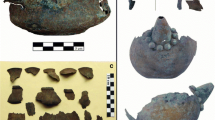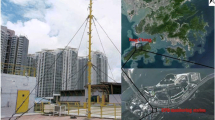Abstract
Corrosion products have been takenfrom 130 copper or bronze outdoor objects all overEurope. Their chemical composition and crystalsymmetry have been determined by means of scanning electron microscopy (SEM/EDS) and X-ray powderdiffraction. Data on location, sampling, objectcharacteristics, general environment and air pollutionlevel; type, colour and chemical composition of thecorrosion layers have been obtained and evaluated by multivariate statistical analysis. The resultsverify that the highest air pollution levels are usually associated with the occurrence of thick,black or dark grey corrosion layers on copper orbronze objects, preferentially containing soot, ironoxide hydroxides, and antlerite,Cu3(SO4)(OH)4. Pale green corrosionusually contains brochantite,Cu4(SO4)(OH)6, and is rather associatedwith less polluted areas. Atacamite, a copper hydroxide chloride with the chemical formula Cu2Cl(OH)3, is preferentially observed in coastal regions.In addition, sulphur isotope analyses have beenperformed on eleven corrosion samples from citycenters. The δ34S values are typically inthe region from +4 to +6‰ relative to the sulphurisotope standard CDT (Canyon Diablo Troilite) with amean value of 4.7±1.2 (1σ), therebyindicating that the sulphur in the corrosion layers,in the form of brochantite or antlerite, mainlyoriginates from a similar source despite geographicvariation, most likely sulphur contained in air pollutants.
Similar content being viewed by others
References
Albano, C.: 1995, Personal communication. Umetrics, Umeå, Sweden.
Andersson, P., Torssander, P. and Ingri, J.: 1992, Hydrobiologia 235/236, 205.
Bužek, F. and Srámek, J.: 1985, Studies in Conserv. 30, 171.
Coleman, M. and Moore, M. P.: 1978, Analytical Chemistry 50, 1594.
Del Monte, M., Sabbioni, C. and Vittori, O.: 1981, Atmospheric Environment 15, 645.
Del Monte, M., Sabbioni, C. and Vittori, O.: 1984, The Science of Total Environment 36, 369.
Gettens, R. J.: 1933, Technical Studies in the field of Fine Arts 2, 31.
Graedel, R. J.: 1987, Corrosion Science 27, 721.
Graedel, T. E., Nassau, K. and Franey, J. P.: 1987, Corrosion Science 27, 639.
Grennfeld, P., Rodhe, H., Thörnelöf, E. and Wisniewski, J. (eds.): 1995, Acid Reign '95. Proceedings from the 5th International Conference on Acidic Deposition, Kluwer Academic Publishers, Vol. 1–4, Dordrecht, The Netherlands.
Ingri, J., Torssander, P., Mörth, C. M., Andersson, P. and Kusakabe, M.: 1995, Thesis 290, Inst. of Geology, University of Stockholm.
Krouse, H. R. and Grinenko, V. A. (eds.): 1991, Stable Isotopes–Natural and Anthropogenic Sulphur in the Environment, J. Wiley & Sons, Chichester–New York–Brisbane–Toronto.
Longinelli, A. and Bartelloni, M.: 1978, Water, Air, and Soil Pollut. 10, 335.
Mattsson, E.: 1992, Electrochemistry and Corrosion Science, Swedish Corrosion Institute, Bulletin No. 100, Stockholm.
Matyi, R. J. and Baboian, R.: 1986, Powder Diffr. 1(4), 299.
Mörth, C. M.: 1999, Personal communication (Department of Geology, University of Stockholm).
Nielsen, T.: 1996, Atmospheric Environment 30, 3481.
Nord, A. G.: 1995, Geol. Fören. Stockholm Förhandl. (GFF) 117, 43.
Nord, A. G. and Ericsson, T.: 1993, Studies in Conservation 38, 25.
Nord, A. G., Svärdh, A. and Tronner, T.: 1994, Atmospheric Environment 28, 2615.
Nord, A. G. and Tronner, K.: 1995, Water, Air, and Soil Pollut. 85, 2719.
Pourbaix, M.: 1977, NBS Special Publ. 479, 1–16. US Dept. of Commerce, National Bureau of Standards, Washington DC.
Pye, K. and Schiavon, N.: 1989, Nature 342, 663.
Saiz-Jimenez, C.: 1993, Atmospheric Environment 27B, 77.
Shennan, S.: 1988, Quantifying Archaeology, Edinburgh University press.
Strandberg, H.; 1997, Dissertation, University of Göteborg, Sweden.
Wold, S., Esbensen, K. and Geladi, P.: 1987, Chemimetrics and Intelligent Laboratory Systems 2, 37.
Wold, S., Albano, C. and Dunn, W. J.: 1989, ‘Multivariate Data Analysis: Converting Chemical Data Tables to Plots’, in Computer Applications in Chemical Research and Education, A. Hültig Verlag, Heidelberg.
Author information
Authors and Affiliations
Corresponding author
Rights and permissions
About this article
Cite this article
Nord, A.G., Tronner, K. & Boyce, A.J. Atmospheric Bronze and Copper Corrosion as an Environmental Indicator. A Study Based on Chemical and Sulphur Isotope Data. Water, Air, & Soil Pollution 127, 193–204 (2001). https://doi.org/10.1023/A:1005254913598
Issue Date:
DOI: https://doi.org/10.1023/A:1005254913598




